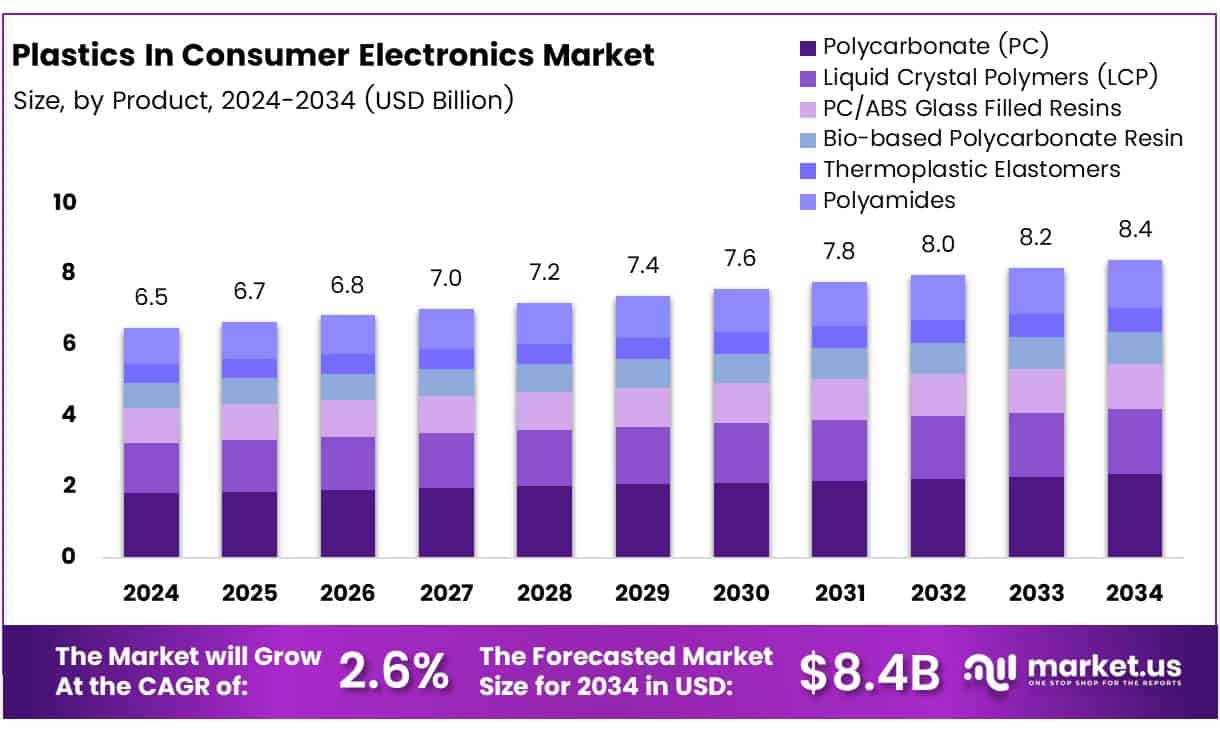Table of Contents
Market Overview
The Global Plastics In Consumer Electronics Market size is expected to be worth around USD 8.4 Billion by 2034, from USD 6.5 Billion in 2024, growing at a CAGR of 2.6% during the forecast period.
The Plastics in Consumer Electronics Market is growing fast. Demand for light, strong, and low-cost materials is rising. Devices like smartphones, laptops, and wearables need durable plastics. An average smartphone uses around 20 grams of plastic. ABS plastic holds nearly 30% share in electronic device plastics. It offers strength, heat resistance, and easy molding.

Growth is also driven by design flexibility needs. Mini and smart devices boost plastic use in electronics. More brands now want cost savings and lighter devices. This opens new market opportunities worldwide. Custom plastic solutions are in high demand today. Bio-based and recyclable plastics are also gaining traction.
Governments are investing in e-waste control systems. Green electronics and recycling rules are getting stronger. Companies are pushed to reduce plastic usage and waste. Countries now support R&D for biodegradable plastic. These changes open growth for eco-friendly plastic makers.
At the same time, pollution concerns are rising. Up to 9 million tons of plastic waste enters oceans every year. New rules now limit harmful plastic use in electronics. Brands that use safe, recyclable plastics gain trust. Sustainable plastic adoption will drive future demand. Firms with eco-focus will lead in this competitive market.
Key Takeaways
- The global plastics in consumer electronics market will grow from USD 6.5 billion (2024) to USD 8.4 billion (2034) at a 2.6% CAGR.
- Polycarbonate (PC) dominates the product segment with a 33.2% market share in 2024 due to its strength and heat resistance.
- Laptop monitor enclosures account for a notable 22.3% share in the end-use segment.
- Asia Pacific leads globally with a 68.2% market share, supported by major manufacturing hubs in China, South Korea, and Taiwan.
Growth Drivers
- Lightweight Demand: Plastics are lighter and more moldable than metals, ideal for slim electronics.
- Design Flexibility: Easy to mold for complex designs and fewer parts, saving time and cost.
- Cost-Effective: Cheaper to process than metals or ceramics in mass production.
- Durable & Insulating: Protects against moisture, dust, and electricity, enhancing device safety.
- Rising Device Use: Surge in smartphones, laptops, and smart appliances drives plastic demand.
Segmentation Insights
Product Analysis
In 2024, Polycarbonate led with 33.2% share for its strength and heat resistance. LCP, PC/ABS, and Polyamides followed for thermal and structural benefits. Bio-based PC and Elastomers gained traction for eco and ergonomic uses.
End Use Analysis
Laptop Enclosures topped with 22.3% share, driven by remote work. TV Frames, Hand-held Devices, Wearables, and Appliances followed due to demand for smart, stylish, and durable designs.
Take advantage of our unbeatable offer - buy now!

Regional Insights
- In 2024, Asia Pacific led the market with a 68.2% share (USD 4.42 billion), driven by strong manufacturing in China, South Korea, and Taiwan.
- North America followed, boosted by 5G tech and top brands like Apple.
- Europe focused on sustainable, recycled plastics due to strict regulations.
- Latin America and Middle East & Africa showed fast growth, fueled by urbanization and rising electronics use.
Sustainability Trends
- Biodegradable and recycled plastics to meet environmental goals.
- Flame-retardant plastics that comply with safety regulations.
- Smart plastics that support wireless charging, thermal dissipation, and EMI shielding.
Competitive Landscape
- New product development with enhanced mechanical and thermal properties.
- Partnerships with electronics OEMs for long-term contracts.
- Regional expansion and investment in sustainable material technology.
Future Outlook
The Plastics in Consumer Electronics Market is projected to grow consistently, driven by the proliferation of smart devices, ongoing material innovation, and increased focus on environmental sustainability. As electronics become more integrated into daily life, and as consumers expect smarter, sleeker, and more durable gadgets, plastics will remain a critical enabler of design and function in the global electronics value chain.
Recent Developments
- In Feb 2025, Resynergi raised $18M in Series B extension led by Taranis to boost plastic-to-fuel tech and scale operations.
- In Mar 2025, HUL to acquire 14.3% stake in Lucro Plastecycle to support plastic recycling and circular economy in India.
- In May 2025, ReVentas secured funding to scale its advanced plastic recycling tech and expand globally.
- In May 2025, Lignin Industries AB raised €3.9M to commercialize and scale Renol, its bio-based thermoplastic.
- In Jun 2025, Jet Investment acquired majority stake in Plastiwell International to expand sustainable plastics manufacturing in Europe.
Conclusion
The Plastics in Consumer Electronics Market is set to reach USD 8.4 billion by 2034, growing at a 2.6% CAGR. Demand is driven by lightweight, durable, and low-cost plastics used in smartphones, laptops, and smart devices. Polycarbonate and ABS lead due to strength and heat resistance. Sustainability, design flexibility, and regulatory pressure are pushing growth in bio-based and recycled plastics. Asia Pacific remains the top market, backed by strong manufacturing. Recent investments and partnerships highlight a shift toward eco-friendly solutions. Firms focused on green innovation and smart materials will lead this evolving market.
Discuss your needs with our analyst
Please share your requirements with more details so our analyst can check if they can solve your problem(s)



